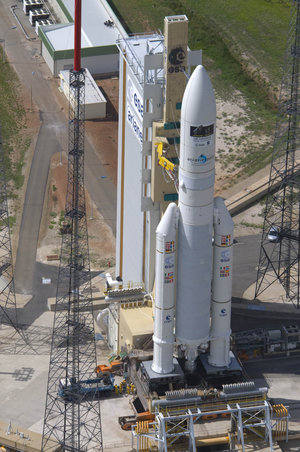Accept all cookies Accept only essential cookies See our Cookie Notice

About ESA
The European Space Agency (ESA) is Europe’s gateway to space. Its mission is to shape the development of Europe’s space capability and ensure that investment in space continues to deliver benefits to the citizens of Europe and the world.
Highlights
ESA - United space in Europe
This is ESA ESA facts Member States & Cooperating States Funding Director General Top management For Member State Delegations European vision European Space Policy ESA & EU Space Councils Responsibility & Sustainability Annual Report Calendar of meetings Corporate newsEstablishments & sites
ESA Headquarters ESA ESTEC ESA ESOC ESA ESRIN ESA EAC ESA ESAC Europe's Spaceport ESA ESEC ESA ECSAT Brussels Office Washington OfficeWorking with ESA
Business with ESA ESA Commercialisation Gateway Law at ESA Careers Cyber resilience at ESA IT at ESA Newsroom Partnerships Merchandising Licence Education Open Space Innovation Platform Integrity and Reporting Administrative Tribunal Health and SafetyMore about ESA
History ESA Historical Archives Exhibitions Publications Art & Culture ESA Merchandise Kids Diversity ESA Brand Centre ESA ChampionsLatest
Space in Member States
Find out more about space activities in our 23 Member States, and understand how ESA works together with their national agencies, institutions and organisations.
Science & Exploration
Exploring our Solar System and unlocking the secrets of the Universe
Go to topicAstronauts
Missions
Juice Euclid Webb Solar Orbiter BepiColombo Gaia ExoMars Cheops Exoplanet missions More missionsActivities
International Space Station Orion service module Gateway Concordia Caves & Pangaea BenefitsLatest
Space Safety
Protecting life and infrastructure on Earth and in orbit
Go to topicAsteroids
Asteroids and Planetary Defence Asteroid danger explained Flyeye telescope: asteroid detection Hera mission: asteroid deflection Near-Earth Object Coordination CentreSpace junk
About space debris Space debris by the numbers Space Environment Report In space refuelling, refurbishing and removingSafety from space
Clean Space ecodesign Zero Debris Technologies Space for Earth Supporting Sustainable DevelopmentLatest
Applications
Using space to benefit citizens and meet future challenges on Earth
Go to topicObserving the Earth
Observing the Earth Future EO Copernicus Meteorology Space for our climate Satellite missionsCommercialisation
ESA Commercialisation Gateway Open Space Innovation Platform Business Incubation ESA Space SolutionsLatest
Enabling & Support
Making space accessible and developing the technologies for the future
Go to topicBuilding missions
Space Engineering and Technology Test centre Laboratories Concurrent Design Facility Preparing for the future Shaping the Future Discovery and Preparation Advanced Concepts TeamSpace transportation
Space Transportation Ariane Vega Space Rider Future space transportation Boost! Europe's Spaceport Launches from Europe's Spaceport from 2012Latest

Ariane 5 launchers with science missions onboard
Thank you for liking
You have already liked this page, you can only like it once!
If it wasn’t for launch capabilities we would never have delved deep into the echo of the Big Bang nor lived out the adventures of Rosetta and Philae at Comet 67P/Churyumov-Gerasimenko. Nor would we have captured some of the Universe’s most energetic phenomena, or be on our way to the innermost planet of the Solar System. Some of ESA’s biggest science missions only got off the ground – literally – thanks to the mighty Ariane 5, one of the most reliable launchers that gives access to space from Europe’s Spaceport in Kourou, French Guiana.
ESA has been using the Ariane family of launch vehicles right back since Ariane 1, which launched the comet-chaser Giotto, ESA’s first deep space mission, in 1985. Later, the astrometry satellite Hipparcos rode into space on an Ariane 4 in 1989 and the Infrared Space Observatory launched in 1995.
One of the first Ariane 5 flights took XMM-Newton into space twenty years ago, in December 1999 (leftmost image). The X-ray space observatory is an impressive workhorse, enabling ground-breaking discoveries on a range of cosmic mysteries from enigmatic black holes to the evolution of galaxies across the Universe.
SMART-1, Europe’s first mission to the Moon, got its ride to space in 2003 (second image from left). It was used to test solar electric propulsion and other technologies, while performing scientific observations of the Moon. BepiColombo launched in 2018 (far right) on the 101st Ariane 5 launch; it is using electric propulsion, in combination with planetary gravity assists, to reach Mercury.
In between, Rosetta began its ten year journey through the Solar System starting with a boost into space on an Ariane 5 (middle image), and in 2009 Herschel and Planck shared a ride on the same launcher (second from right) from which they would both proceed to the second Lagrange point, L2, 1.5 million km from Earth in the opposite direction to the Sun, to reveal the Universe in new light. Observing in infrared wavelengths, Herschel unlocked the secrets of how stars and galaxies form and evolve, while Planck captured the most ancient light in the Universe, released only 380 000 years after the Big Bang, in greater detail than ever, shedding light on our 13.8 billion year long cosmic history.
Europe’s next generation launchers, including Ariane 6, will provide new opportunities for ESA’s upcoming science missions to fulfil their scientific goals from their various viewpoints in our Solar System.
Rockets are the backbone of all space-based endeavours. ESA in partnership with industry is developing next-generation space transportation vehicles, Ariane 6, Vega-C, and Space Rider. At Space19+, ESA will propose further enhancements to these programmes and introduce new ideas to help Europe work together to build a robust space transportation economy. This week, take a look at what ESA is doing to ensure continued autonomous access to space for Europe and join the conversation online by following the hashtag #RocketWeek
-
CREDIT
ESA/CNES/Arianespace -
LICENCE
ESA Standard Licence

Herschel-Planck fairing ejection

Herschel and Planck launch configuration

Ariane 5 enclosing Herschel and Planck

Ariane 5 enclosing Herschel and Planck















 Germany
Germany
 Austria
Austria
 Belgium
Belgium
 Denmark
Denmark
 Spain
Spain
 Estonia
Estonia
 Finland
Finland
 France
France
 Greece
Greece
 Hungary
Hungary
 Ireland
Ireland
 Italy
Italy
 Luxembourg
Luxembourg
 Norway
Norway
 The Netherlands
The Netherlands
 Poland
Poland
 Portugal
Portugal
 Czechia
Czechia
 Romania
Romania
 United Kingdom
United Kingdom
 Slovenia
Slovenia
 Sweden
Sweden
 Switzerland
Switzerland
























